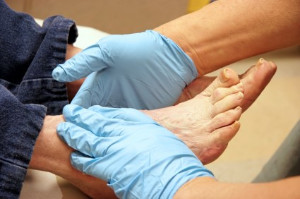Connect With Us
Blog

If you walk around feeling like you have a pebble in your shoe under the ball of the foot, you might have Morton’s neuroma. This is a thickening of the tissues next to nerves leading to the toe. Women are much more likely to suffer from this condition than men because they are more apt to wear high heels, which put pressure on the feet. Wearing shoes that are too tight or narrow may also lead to this uncomfortable foot ailment. Beyond feeling like there is a pebble under your foot, one can experience pain, burning, cramping, and/or numbness of the foot. Rest, foot stretching exercises to promote blood circulation, massaging the affected part of the foot, using shoe pads or orthotics to help absorb pressure, and wearing well fitting, flatter, supportive shoes should all help with irritation of a Morton’s neuroma. However, if you are having troubling symptoms for a prolonged time, it is suggested that you contact a podiatrist for proper diagnosis and a treatment plan.
Morton’s neuroma is a very uncomfortable condition to live with. If you think you have Morton’s neuroma, contact Dr. Richard Silverstein of Union Foot Care. Our doctor will attend to all of your foot care needs and answer any of your related questions.
Morton’s Neuroma
Morton's neuroma is a painful foot condition that commonly affects the areas between the second and third or third and fourth toe, although other areas of the foot are also susceptible. Morton’s neuroma is caused by an inflamed nerve in the foot that is being squeezed and aggravated by surrounding bones.
What Increases the Chances of Having Morton’s Neuroma?
- Ill-fitting high heels or shoes that add pressure to the toe or foot
- Jogging, running or any sport that involves constant impact to the foot
- Flat feet, bunions, and any other foot deformities
Morton’s neuroma is a very treatable condition. Orthotics and shoe inserts can often be used to alleviate the pain on the forefront of the feet. In more severe cases, corticosteroids can also be prescribed. In order to figure out the best treatment for your neuroma, it’s recommended to seek the care of a podiatrist who can diagnose your condition and provide different treatment options.
If you have any questions, please feel free to contact our office located in Havre de Grace, MD . We offer the newest diagnostic and treatment technologies for all your foot care needs.

It is crucial for diabetic patients to check and manage their glucose levels daily, despite the time it can take from completing daily activities. The feet can typically be at risk in people who have diabetes, and this can be a result of the inability to feel sensations related to the feet. It is important to look for existing cuts, bruises, or scrapes. Some patients prefer to use a mirror to look at the sole of the foot. Diabetic foot care begins with washing and drying the feet daily, followed by using a good moisturizer on the entire foot except for the toes. It is common for diabetic patients to have poor circulation, and this can make it difficult for sores on the foot to heal. Foot ulcers are cuts or wounds on the feet that have become infected, and must be treated immediately to avoid possible gangrene. If you are diabetic, it is strongly suggested that you are under the care of a podiatrist who properly treats and offers helpful management tips.
Diabetic foot care is important in preventing foot ailments such as ulcers. If you are suffering from diabetes or have any other concerns about your feet, contact Dr. Richard Silverstein from Union Foot Care. Our doctor can provide the care you need to keep you pain-free and on your feet.
Diabetic Foot Care
Diabetes affects millions of people every year. The condition can damage blood vessels in many parts of the body, especially the feet. Because of this, taking care of your feet is essential if you have diabetes, and having a podiatrist help monitor your foot health is highly recommended.
The Importance of Caring for Your Feet
- Routinely inspect your feet for bruises or sores.
- Wear socks that fit your feet comfortably.
- Wear comfortable shoes that provide adequate support.
Patients with diabetes should have their doctor monitor their blood levels, as blood sugar levels play such a huge role in diabetic care. Monitoring these levels on a regular basis is highly advised.
It is always best to inform your healthcare professional of any concerns you may have regarding your feet, especially for diabetic patients. Early treatment and routine foot examinations are keys to maintaining proper health, especially because severe complications can arise if proper treatment is not applied.
If you have any questions please feel free to contact our office located in Havre de Grace, MD . We offer the newest diagnostic and treatment technologies for all your foot and ankle needs.

It is crucial for diabetic patients to check and manage their glucose levels daily, despite the time it can take from completing daily activities. The feet can typically be at risk in people who have diabetes, and this can be a result of the inability to feel sensations related to the feet. It is important to look for existing cuts, bruises, or scrapes. Some patients prefer to use a mirror to look at the sole of the foot. Diabetic foot care begins with washing and drying the feet daily, followed by using a good moisturizer on the entire foot except for the toes. It is common for diabetic patients to have poor circulation, and this can make it difficult for sores on the foot to heal. Foot ulcers are cuts or wounds on the feet that have become infected, and must be treated immediately to avoid possible gangrene. If you are diabetic, it is strongly suggested that you are under the care of a podiatrist who properly treats and offers helpful management tips.
Diabetic foot care is important in preventing foot ailments such as ulcers. If you are suffering from diabetes or have any other concerns about your feet, contact Dr. Richard Silverstein from Union Foot Care. Our doctor can provide the care you need to keep you pain-free and on your feet.
Diabetic Foot Care
Diabetes affects millions of people every year. The condition can damage blood vessels in many parts of the body, especially the feet. Because of this, taking care of your feet is essential if you have diabetes, and having a podiatrist help monitor your foot health is highly recommended.
The Importance of Caring for Your Feet
- Routinely inspect your feet for bruises or sores.
- Wear socks that fit your feet comfortably.
- Wear comfortable shoes that provide adequate support.
Patients with diabetes should have their doctor monitor their blood levels, as blood sugar levels play such a huge role in diabetic care. Monitoring these levels on a regular basis is highly advised.
It is always best to inform your healthcare professional of any concerns you may have regarding your feet, especially for diabetic patients. Early treatment and routine foot examinations are keys to maintaining proper health, especially because severe complications can arise if proper treatment is not applied.
If you have any questions please feel free to contact our office located in Havre de Grace, MD . We offer the newest diagnostic and treatment technologies for all your foot and ankle needs.

There are specific foot stretches which may help to loosen tight calf muscles, relieve arch cramps, and lessen heel pain. Little or no stretching may result in restricted mobility, and the risk of ripping, tearing, or straining a muscle may increase. Pointing and flexing the feet will successfully stretch the soles of the feet and strengthen the calves. It is important to note that while flexing the foot, it is beneficial to lead with the heel which can help to stretch the calf muscles. Additionally, while pointing the feet, it is more effective when the top of the arch is lengthened and pulled away from the body. When the feet are frequently stretched, chronic foot pain problems may be diminished, and the risk of getting foot and ankle injuries may be reduced. If you would like to know more about how to correctly stretch the feet, please speak with a podiatrist.
Stretching the feet is a great way to prevent injuries. If you have any concerns with your feet consult with Dr. Richard Silverstein from Union Foot Care. Our doctor will assess your condition and provide you with quality foot and ankle treatment.
Stretching the Feet
Stretching the muscles in the foot is an important part in any physical activity. Feet that are tight can lead to less flexibility and make you more prone to injury. One of the most common forms of foot pain, plantar fasciitis, can be stretched out to help ease the pain. Stretching can not only ease pain from plantar fasciitis but also prevent it as well. However, it is important to see a podiatrist first if stretching is right for you. Podiatrists can also recommend other ways to stretch your feet. Once you know whether stretching is right for you, here are some excellent stretches you can do.
- Using a foam roller or any cylindrical object (a water bottle or soda can will do), roll the object under your foot back and forth. You should also exert pressure on the object. Be sure to do this to both feet for a minute. Do this exercise three times each.
- Similar to the previous one, take a ball, such as a tennis ball, and roll it under your foot while seated and exert pressure on it.
- Grab a resistance band or towel and take a seat. If you are using a towel, fold it length wise. Next put either one between the ball of your foot and heel and pull with both hands on each side towards you. Hold this for 15 seconds and then switch feet. Do this three times for each foot.
- Finally hold your big toe while crossing one leg over the other. Pull the toe towards you and hold for 15 seconds. Once again do this three times per foot.
It is best to go easy when first stretching your foot and work your way up. If your foot starts hurting, stop exercising and ice and rest the foot. It is advised to then see a podiatrist for help.
If you have any questions, please feel free to contact our office located in Havre de Grace, MD . We offer the newest diagnostic and treatment technologies for all your foot care needs.
Blog Archives
- April 2024
- March 2024
- February 2024
- January 2024
- December 2023
- November 2023
- October 2023
- September 2023
- August 2023
- July 2023
- June 2023
- May 2023
- April 2023
- March 2023
- February 2023
- January 2023
- December 2022
- November 2022
- October 2022
- September 2022
- August 2022
- July 2022
- June 2022
- May 2022
- April 2022
- March 2022
- February 2022
- January 2022
- December 2021
- November 2021
- October 2021
- September 2021
- August 2021
- July 2021
- June 2021
- May 2021
- April 2021
- March 2021
- February 2021
- January 2021
- December 2020
- November 2020
- October 2020
- September 2020
- August 2020
- July 2020
- June 2020
- May 2020
- April 2020
- March 2020
- February 2020
- January 2020
- December 2019
- November 2019
- October 2019
- September 2019
- August 2019
- July 2019
- June 2019
- May 2019
- April 2019
- March 2019
- February 2019
- January 2019
- December 2018
- November 2018
- October 2018
- September 2018
- August 2018
- July 2018
- June 2018
- May 2018
- April 2018
- March 2018
- February 2018
- January 2018
- December 2017
- November 2017
- October 2017
- September 2017
- August 2017
- July 2017
- June 2017
- May 2017
- April 2017
- March 2017
- February 2017
- January 2017
- December 2016
- November 2016
- October 2016
- September 2016
- August 2016
- July 2016
- June 2016
- May 2016
